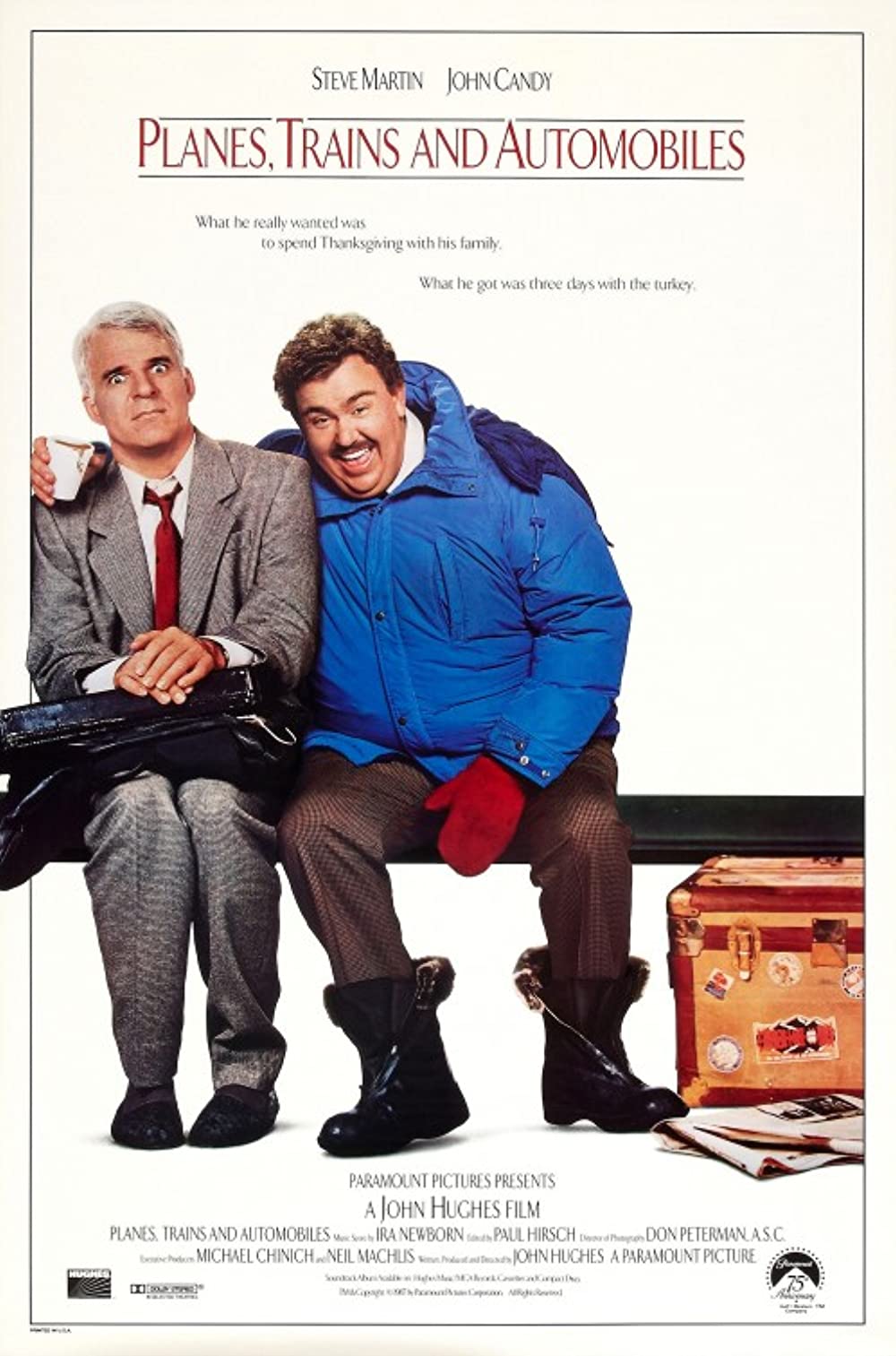Synopsis
Neal Page (Martin) is an advertising executive on a business trip to New York City. Eager to return home to his family in Chicago for Thanksgiving, Page attempts to hail a cab to the airport. After losing a cab to Jake Briggs (Kevin Bacon from Hughes’ 1988 release, She’s Having a Baby) and getting extorted by a lawyer, his cab is inadvertently stolen by Del Griffith (Candy).
Page eventually makes it to the airport, but his flight is delayed. When he’s on the plane, he is bumped to coach with a seat right next to Del, a loquacious traveling salesman who sells shower curtain rings. When the weather diverts their plane to Wichita, Del offers to share a hotel room. The cynical, short-tempered Neil cannot deal with Del’s eccentricities and lashes out.
Throughout Planes, Trains and Automobiles, the pair continually attempt to navigate their way towards Chicago, in an all-out effort to get Neal back home to his adoring family, in time for Thanksgiving dinner. Will they be able to make it? More importantly, will they be able to get there without killing each other?
Themes
Planes, Trains, and Automobiles is a film that plays on the familiar trope that was often seen throughout comedies of the 1980s – that of a mismatched pair. Stuck together through unforeseen circumstances, these two eventually come to grow and form mutual respect and adoration for each other.
Some of the best comedy is borne out of darkness and sadness, and the two leads here personify that the best. Neal is painfully unlikeable outside of being Steve Martin and having a family. His inherent darkness eventually leads to emotional outbursts which lend themselves to comedy, but also directly into relatability.
Del uses this verisimilitude of confidence to mask his pain and sadness. Instead of having a situation where he has to be vulnerable, Candy powers through with a nothing story or anecdote. When Neal’s barrage of insults breaks down that confidence, that vulnerability comes out, hitting the emotional peak of the film. The scene in question occurs only 30 minutes in.
It’s a testament to the film’s approach to self-love and perspective that gives Neal the opportunity to cut Del a bit of slack. From that point on, Neal is much more accepting of Del and others. Specifically, when the two travel by train, Neal strikes up small talk with the woman next to him, much like Del would.
Del Griffith’s character is simultaneously optimistic and fastidious. When the pair lose all their money, Del sells his shower curtain rings as earrings, earning them enough money to eat, while drawing the unnecessary ire of Neal. Each time Del makes inroads with Neal, something throws him back. Yet, with each successive attempt at splitting up, either circumstance or sympathy brings Neal back to Del.
Cast
In Planes, Trains, and Automobiles, Martin and Candy are the only characters with any significant screentime throughout the film. Despite this, their push-pull rapport and general movie star qualities never invite anyone else to dominate.
Martin plays the straight man, but his comedic sensibilities kick into high gear when faced with increasingly ridiculous situations. His physical comedic skills are held mostly in check, but he does pull out the rubbery face when the scenes call for it.
Candy gives a career-defining performance. Del is a man hiding an immense amount of pain behind a veil of never-ending gab and a facade of contentment. When his pain is slowly pulled out, it is never in this large display of emotion, but rather as something that has to be intimated by Neal. As much as he wants to be happy and together with someone else, he also is painfully self-aware of his own effect on people.
Famous character actors like Dylan Walsh, Michael McKean, Ben Stein, Martin Ferraro, and Larry Hankin all pop up for briefly memorable roles, but no one shines like Edie McClurg. In the famous F-word rant scene, her midwestern pep and simple nature prove the perfect foil for an exasperated Neal. The actress herself claims people regularly come up to her just to curse in her face.
Conclusion
Planes, Trains, and Automobiles has stood the test of time for a number of reasons, but overall, it’s because it’s still a really funny film. The chemistry between Steve Martin and John Candy, and the film’s eventual sweetness, is what elevates this timeless classic over other comedies of the era. This Thanksgiving, gather your family and watch this film…but maybe shield the kids from the F-word scene.
